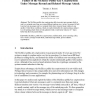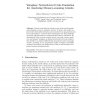163 search results - page 6 / 33 » WiFi attack vectors |
ICDCS
2003
IEEE
14 years 3 months ago
2003
IEEE
Remotely executing mobile code introduces a plethora of security problems. This paper examines the “external agent replay” attack, identifies the notion of one-way program st...
GLOBECOM
2009
IEEE
14 years 1 months ago
2009
IEEE
Secure communications in wireless ad hoc networks require setting up end-to-end secret keys for communicating node pairs. Due to physical limitations and scalability requirements, ...
CRYPTO
1997
Springer
14 years 1 months ago
1997
Springer
: The McEliece public-key cryptosystem fails to protect any message which is sent to a recipient more than once using different random error vectors. In general, it fails to protec...
FSE
1998
Springer
14 years 1 months ago
1998
Springer
In this paper we discuss PRNGs: the mechanisms used by real-world secure systems to generate cryptographic keys, initialization vectors, "random" nonces, and other values...
DIMVA
2009
13 years 10 months ago
2009
Remote code-injection attacks are one of the most frequently used attacking vectors in computer security. To detect and analyze injected code (often called shellcode), some researc...


